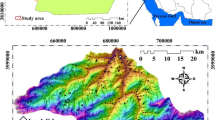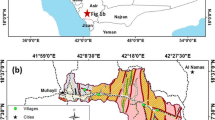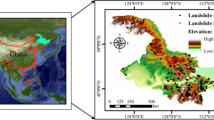Abstract
As global warming accelerates, abnormal weather events are occurring more frequently. In the twenty-first century in particular, hydrological disruption has increased as water flows have changed globally, causing the strength and frequency of hydrological disasters to increase. The damage caused by such disasters in urban areas can be extreme, and the creation of landslide susceptibility maps to predict and analyze the extent of future damage is an urgent necessity. Therefore, in this study, probabilistic and data mining approaches were utilized to identify landslide-susceptible areas using aerial photographs and geographic information systems. Areas where landslides have occurred were located through interpretation of aerial photographs and field survey data. In addition, topographic maps generated from aerial photographs were used to determine the values of topographic factors. A frequency ratio (FR) model was utilized to examine the influences of topographic, soil and vegetation factors on the occurrence of landslides. A total of 23 variables that affect landslide frequency were selected through FR analysis, and a spatial database was constructed. Finally, a boosted tree model was applied to determine the correlations between various factors and landslide occurrence. Correlations among related input variables were calculated as predictor importance values, and sensitivity analysis was performed to quantitatively analyze the impact of each variable. The boosted tree model showed validation accuracies of 77.68 and 78.70% for the classification and regression algorithms using receiver operating characteristic curve, respectively. Reliable accuracy can provide a scientific basis to urban municipalities for policy recommendations in the management of urban landslides.









Similar content being viewed by others

References
Aghdam IN, Varzandeh MHM, Pradhan B (2016) Landslide susceptibility mapping using an ensemble statistical index (Wi) and adaptive neuro-fuzzy inference system (ANFIS) model at Alborz Mountains (Iran). Environ Earth Sci 75:1–20
Aghdam IN, Pradhan B, Panahi M (2017) Landslide susceptibility assessment using a novel hybrid model of statistical bivariate methods (FR and WOE) and adaptive neuro-fuzzy inference system (ANFIS) at southern Zagros Mountains in Iran. Environ Earth Sci 76:237
Ahmed B, Dewan A (2017) Application of bivariate and multivariate statistical techniques in landslide susceptibility modeling in Chittagong City Corporation, Bangladesh. Remote Sens 9:304
Anbalagan P, Chandrasekaran R (2015) A novel weighted decision tree prediction model for landslide risk analysis. Adv Nat Appl Sci 9:22–29
Bartelletti C, Giannecchini R, D’Amato Avanzi G, Galanti Y, Mazzali A (2017) The influence of geological–morphological and land use settings on shallow landslides in the Pogliaschina T. basin (northern Apennines, Italy). J Maps 13:142–152
Bathrellos GD, Gaki-Papanastassiou K, Skilodimou HD, Papanastassiou D, Chousianitis KG (2012) Potential suitability for urban planning and industry development using natural hazard maps and geological–geomorphological parameters. Environ Earth Sci 66:537–548
Bathrellos GD, Skilodimou HD, Chousianitis K, Youssef AM, Pradhan B (2017) Suitability estimation for urban development using multi-hazard assessment map. Sci Total Environ 575:119–134
Beven K, Kirkby MJ (1979) A physically based, variable contributing area model of basin hydrology/Un modèle à base physique de zone d’appel variable de l’hydrologie du bassin versant. Hydrol Sci J 24:43–69
Böhner J, Selige T (2006) Spatial prediction of soil attributes using terrain analysis and climate regionalisation. Gottinger Geographische Abhandlungen 115:13–28
Brenning A, Schwinn M, Ruiz-Páez A, Muenchow J (2015) Landslide susceptibility near highways is increased by 1 order of magnitude in the Andes of southern Ecuador, Loja province. Nat Hazards Earth Syst Sci 15:45–57
Chen G, Yang J, Bao Q, Wang W-C (2017a) Intraseasonal responses of the East Asia summer rainfall to anthropogenic aerosol climate forcing. Clim Dyn 1–14
Chen T, Trinder JC, Niu R (2017b) Object-oriented landslide mapping using ZY-3 satellite imagery, random forest and mathematical morphology, for the Three-Gorges Reservoir, China. Remote Sens 9:333
Chen W, Pourghasemi HR, Zhao Z (2017c) A GIS-based comparative study of Dempster-Shafer, logistic regression and artificial neural network models for landslide susceptibility mapping. Geocarto Int 32:367–385
Choi J, Oh H-J, Lee H-J, Lee C, Lee S (2012) Combining landslide susceptibility maps obtained from frequency ratio, logistic regression, and artificial neural network models using ASTER images and GIS. Eng Geol 124:12–23
Chousianitis K, Del Gaudio V, Sabatakakis N, Kavoura K, Drakatos G, Bathrellos GD, Skilodimou HD (2016) Assessment of earthquake-induced landslide hazard in Greece: from Arias intensity to spatial distribution of slope resistance demand. Bull Seismol Soc Am 106:174–188
Conrad O et al (2015) System for automated geoscientific analyses (SAGA) v. 2.1. 4. Geosci Model Dev 8:1991–2007
De Novellis V, Castaldo R, Lollino P, Manunta M, Tizzani P (2016) Advanced three-dimensional finite element modeling of a slow landslide through the exploitation of DInSAR measurements and in situ. Surv Remote Sens 8:670
Dietrich H, Böhner J (2008) Cold air production and flow in a low mountain range landscape in Hessia (Germany). In: SAGA—seconds out, Hamburger Beiträge Zur Physischen Geographie Und Landschaftsökologie, Univ Hamburg, Inst für Geographie, Hamburg, pp 37–48
Doetterl S, Berhe AA, Nadeu E, Wang Z, Sommer M, Fiener P (2016) Erosion, deposition and soil carbon: a review of process-level controls, experimental tools and models to address C cycling in dynamic landscapes. Earth Sci Rev 154:102–122
Feizizadeh B, Roodposhti MS, Blaschke T, Aryal J (2017) Comparing GIS-based support vector machine kernel functions for landslide susceptibility mapping. Arab J Geosci 10:122
Foster G, Wischmeier W (1974) Evaluating irregular slopes for soil loss prediction. Trans ASAE 17:305–0309
Friedman N, Goldszmidt M (1998) Learning Bayesian networks with local structure. In: Learning in graphical models. Springer, Berlin, pp 421–459
Gonçalves J, Henriques R (2015) UAV photogrammetry for topographic monitoring of coastal areas. Int J Photogramm Remote Sens 104:101–111
Gorsevski PV, Brown MK, Panter K, Onasch CM, Simic A, Snyder J (2016) Landslide detection and susceptibility mapping using LiDAR and an artificial neural network approach: a case study in the Cuyahoga Valley National Park. Ohio Landslides 13:467–484
Guisan A, Weiss SB, Weiss AD (1999) GLM versus CCA spatial modeling of plant species distribution. Plant Ecol 143:107–122
Hastie R (2001) Problems for judgment and decision making. Annu Rev Psychol 52:653–683
Hess DM, Leshchinsky BA, Bunn M, Mason HB, Olsen MJ (2017) A simplified three-dimensional shallow landslide susceptibility framework considering topography and seismicity. Landslides 1–21
Hjerdt K, McDonnell J, Seibert J, Rodhe A (2004) A new topographic index to quantify downslope controls on local drainage. Water Resour Res 40
Hong H, Pourghasemi HR, Pourtaghi ZS (2016a) Landslide susceptibility assessment in Lianhua County (China): a comparison between a random forest data mining technique and bivariate and multivariate statistical models. Geomorphology 259:105–118
Hong H, Pradhan B, Bui DT, Xu C, Youssef AM, Chen W (2016b) Comparison of four kernel functions used in support vector machines for landslide susceptibility mapping: a case study at Suichuan area (China). Geomat Nat Hazards Risk 1–26
Iwahashi J, Pike RJ (2007) Automated classifications of topography from DEMs by an unsupervised nested-means algorithm and a three-part geometric signature. Geomorphology 86:409–440
Jones D, Brunsden D, Goudie A (1983) A preliminary geomorphological assessment of part of the Karakoram Highway. Q J Eng Geol Hydrogeol 16:331–355
Kim MS, Onda Y, Uchida T, Kim JK (2016) Effects of soil depth and subsurface flow along the subsurface topography on shallow landslide predictions at the site of a small granitic hillslope. Geomorphology 271:40–54
Korea Forest Service (2013) 2013 detailed strategy for primary policy. Korea Forest Service, Seoul
Korean Geotechnical Society (2011) Cause investigation of Umyeonsan landslide and recovery measure establishment service final report. Korean Geotechnical Society, Seoul
Kornejady A, Ownegh M, Bahremand A (2017) Landslide susceptibility assessment using maximum entropy model with two different data sampling methods. Catena 152:144–162
Krauss C, Do XA, Huck N (2017) Deep neural networks, gradient-boosted trees, random forests: Statistical arbitrage on the S&P 500. Eur J Oper Res 259:689–702
Kurban A, Strobl J, Amanambu A, Khan G, Valentine M (2018) A bivariate statistical technique with knowledge-based analytical hierarchy process for landslide susceptibility assessment in Naryn River Basin, Kyrgyzstan. Int J Geoinfo 14
Lee S (2005) Application of logistic regression model and its validation for landslide susceptibility mapping using GIS and remote sensing data. Int J Remote Sens 26:1477–1491
Lee S (2013) Landslide detection and susceptibility mapping in the Sagimakri area, Korea using KOMPSAT-1 and weight of evidence technique. Environ Earth Sci 70:3197–3215
Lee S, Evangelista D (2008) Landslide susceptibility mapping using probability and statistics models in Baguio City. Philippines Department of Environment and Natural Resources, Quezon City
Lee S, Min K (2001) Statistical analysis of landslide susceptibility at Yongin, Korea. Environ Geol 40:1095–1113
Lee S, Pradhan B (2006) Landslide hazard assessment at Cameron Highland Malaysia using frequency ratio and logistic regression models. In: Geophysical research abstracts, p 03241
Lee S, Chwae U, Min K (2002) Landslide susceptibility mapping by correlation between topography and geological structure: the Janghung area, Korea. Geomorphology 46:149–162
Lee S, Choi J, Min K (2004a) Probabilistic landslide hazard mapping using GIS and remote sensing data at Boun, Korea. Int J Remote Sens 25:2037–2052
Lee S, Ryu J-H, Won J-S, Park H-J (2004b) Determination and application of the weights for landslide susceptibility mapping using an artificial neural network. Eng Geol 71:289–302
Lee M-J, Song W-K, Won J-S, Park I, Lee S (2014) Spatial and temporal change in landslide hazard by future climate change scenarios using probabilistic-based frequency ratio model. Geocarto Int 29:639–662
Lee M, Park I, Won J, Lee S (2016) Landslide hazard mapping considering rainfall probability in Inje, Korea. Geomat Nat Hazards Risk 7:424–446
Lee S, Hong S-M, Jung H-S (2017) A support vector machine for landslide susceptibility mapping in Gangwon Province, Korea. Sustainability 9:48
Li Z, Shi W, Lu P, Yan L, Wang Q, Miao Z (2016a) Landslide mapping from aerial photographs using change detection-based Markov random field. Remote Sens Environ 187:76–90
Li Z, Shi W, Myint SW, Lu P, Wang Q (2016b) Semi-automated landslide inventory mapping from bitemporal aerial photographs using change detection and level set method. Remote Sens Environ 175:215–230
Li G, Lei Y, Yao H, Wu S, Ge J (2017) The influence of land urbanization on landslides: an empirical estimation based on Chinese provincial panel data. Sci Tot Environ 595:681–690
Liu C et al (2016) Assessment of regional shallow landslide stability based on airborne laser scanning data in the Yingxiu area of Sichuan Province (China). Eur J Remote Sens 49:835–860
Mateos RM et al (2016) The combined use of PSInSAR and UAV photogrammetry techniques for the analysis of the kinematics of a coastal landslide affecting an urban area (SE Spain). Landslides 1–12
Moore ID, Grayson R, Ladson A (1991) Digital terrain modelling: a review of hydrological, geomorphological, and biological applications. Hydrol Process 5:3–30
Mukhopadhyay S, Kulkarni S, Kulkarni P, Dutta S (2016) Rainfall statistics change in West Bengal (India) from period 1901–2000. In: Geostatistical and geospatial approaches for the characterization of natural resources in the environment. Springer, Berlin, pp 173–181
Naghibi SA, Pourghasemi HR, Dixon B (2016) GIS-based groundwater potential mapping using boosted regression tree, classification and regression tree, and random forest machine learning models in Iran. Environ Monit Assess 188:44
Oh H-J, Lee S, Soedradjat GM (2010) Quantitative landslide susceptibility mapping at Pemalang area, Indonesia. Environ Earth Sci 60:1317–1328
Ohmynews (2011) The cause of landslides in Umyeon is heavy rains and clogged drainage
Pachauri RK et al (2014) Climate change 2014: synthesis report. Contribution of Working Groups I, II and III to the fifth assessment report of the Intergovernmental Panel on Climate Change. IPCC
Panagos P, Borrelli P, Meusburger K (2015) A new European slope length and steepness factor (LS-factor) for modeling soil erosion by water. Geosciences 5:117–126
Papadopoulou-Vrynioti K, Bathrellos GD, Skilodimou HD, Kaviris G, Makropoulos K (2013) Karst collapse susceptibility mapping considering peak ground acceleration in a rapidly growing urban area. Eng Geol 158:77–88
Park I, Lee S (2014) Spatial prediction of landslide susceptibility using a decision tree approach: a case study of the Pyeongchang area, Korea. Int J Remote Sens 35:6089–6112
Paudel U, Oguchi T, Hayakawa Y (2016) Multi-resolution landslide susceptibility analysis using a DEM and random forest. Int J Geosci 7:726
Pham BT, Bui DT, Prakash I, Dholakia M (2017) Hybrid integration of multilayer perceptron neural networks and machine learning ensembles for landslide susceptibility assessment at Himalayan area (India) using GIS. Catena 149:52–63
Poudyal CP, Chang C, Oh H-J, Lee S (2010) Landslide susceptibility maps comparing frequency ratio and artificial neural networks: a case study from the Nepal Himalaya. Environ Earth Sci 61:1049–1064
Pradhan B, Lee S (2010a) Delineation of landslide hazard areas on Penang Island, Malaysia, by using frequency ratio, logistic regression, and artificial neural network models. Environ Earth Sci 60:1037–1054
Pradhan B, Lee S (2010b) Landslide susceptibility assessment and factor effect analysis: backpropagation artificial neural networks and their comparison with frequency ratio and bivariate logistic regression modelling. Environ Model Softw 25:747–759
Pradhan B, Mansor S, Pirasteh S, Buchroithner MF (2011) Landslide hazard and risk analyses at a landslide prone catchment area using statistical based geospatial model. Int J Remote Sens 32:4075–4087
Provost F, Hibert C, Malet JP (2017) Automatic classification of endogenous landslide seismicity using the random forest supervised classifier. Geophys Res Lett 44:113–120
Rahmati O, Pourghasemi HR, Melesse AM (2016) Application of GIS-based data driven random forest and maximum entropy models for groundwater potential mapping: a case study at Mehran Region, Iran. Catena 137:360–372
Rawat M, Joshi V, Rawat B, Kumar K (2011) Landslide movement monitoring using GPS technology: A case study of Bakthang landslide, Gangtok, East Sikkim. India. J Dev Agric Econ 3:194–200
Regmi AD, Devkota KC, Yoshida K, Pradhan B, Pourghasemi HR, Kumamoto T, Akgun A (2014) Application of frequency ratio, statistical index, and weights-of-evidence models and their comparison in landslide susceptibility mapping in Central Nepal Himalaya. Arab J Geosci 7:725–742
Scaioni M, Longoni L, Melillo V, Papini M (2014) Remote sensing for landslide investigations: An overview of recent achievements and perspectives. Remote Sens 6:9600–9652
Schmaltz EM, Steger S, Glade T (2017) The influence of forest cover on landslide occurrence explored with spatio-temporal. information Geomorphology 290:250–264
Seoul Institute (2014) Supplemental investigation report of causes of Umyeonsan landslides. Seoul Institute, Seoul
Singh KK, Singh A (2016) Detection of 2011 Sikkim earthquake-induced landslides using neuro-fuzzy classifier and digital elevation model. Nat Hazards 83:1027–1044
Stumpf A, Malet J-P, Allemand P, Pierrot-Deseilligny M, Skupinski G (2015) Ground-based multi-view photogrammetry for the monitoring of landslide deformation erosion. Geomorphology 231:130–145
The Kyunghyang Shinmun (2011) Umyeonsan Hyungchon village landslide
Tsangaratos P, Ilia I (2016) Landslide susceptibility mapping using a modified decision tree classifier in the Xanthi Perfection, Greece. Landslides 13:305–320
UNISDR (2015) The human cost of natural disasters: a global perspective. CRED, Brussels
Van Westen C, Getahun FL (2003) Analyzing the evolution of the Tessina landslide using aerial photographs and digital elevation models. Geomorphology 54:77–89
Wischmeier WH, Smith DD (1978) Predicting rainfall erosion losses—a guide to conservation planning
Woodget A, Carbonneau P, Visser F, Maddock I (2015) Quantifying submerged fluvial topography using hyperspatial resolution UAS imagery and structure from motion photogrammetry. Earth Surf Process Landf 40:47–64
Yonhapnews (2011a) Survival than ‘well-being’ … Will ecoes come back after Kangnam flood
Yonhapnews (2011b) Umyeonsan landslide 15 deaths … 2 buried (synthesis)
Youssef AM, Pourghasemi HR, Pourtaghi ZS, Al-Katheeri MM (2016) Landslide susceptibility mapping using random forest, boosted regression tree, classification and regression tree, and general linear models and comparison of their performance at Wadi Tayyah Basin, Asir Region, Saudi Arabia. Landslides 13:839–856
Acknowledgements
This research was conducted by Korea Environment Institute (KEI) with support of a Grant (NRF-2018R1D1A1B07041203) by the Program through the National Research Foundation of Korea (NRF). This research was supported by the Basic Research Project of the Korea Institute of Geoscience and Mineral Resources (KIGAM) funded by the Ministry of Science and ICT.
Author information
Authors and Affiliations
Corresponding authors
Electronic supplementary material
Below is the link to the electronic supplementary material.
Rights and permissions
About this article
Cite this article
Lee, S., Lee, MJ. & Lee, S. Spatial prediction of urban landslide susceptibility based on topographic factors using boosted trees. Environ Earth Sci 77, 656 (2018). https://doi.org/10.1007/s12665-018-7778-7
Received:
Accepted:
Published:
DOI: https://doi.org/10.1007/s12665-018-7778-7



